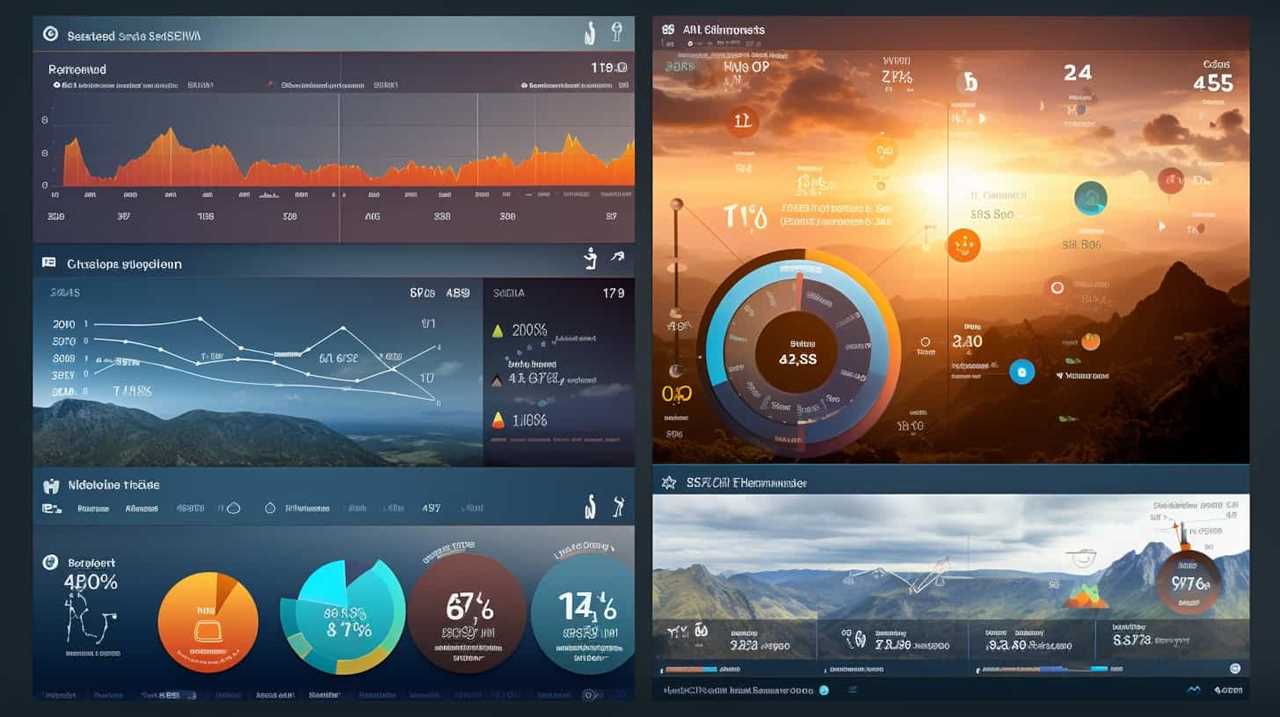We felt unbeatable in our SEO strategies, until we discovered a revolutionary secret: the SEO checklist.
It may sound simple, but this little tool is a game-changer for anyone seeking mastery in the world of search engine optimization.
In this article, we’ll break down what a SEO checklist is, why it’s so important, and how to create an effective one.
Get ready to take your SEO strategy to the next level.

Key Takeaways
- A SEO checklist is crucial for optimizing websites and driving organic traffic.
- Regularly updating and reviewing the checklist helps ensure a strong online presence and improve search engine rankings.
- Backlinks, website speed, on-page optimization, and mobile-friendliness are essential components of a SEO checklist.
- Best practices for a SEO checklist include clear structure, assigning responsibilities, setting deadlines, and tracking progress.
Importance of SEO Checklists
The importance of SEO checklists lies in their ability to guide us in optimizing our websites and driving organic traffic. Regular website updates are crucial for maintaining a strong online presence and improving search engine rankings. By following a comprehensive checklist, we ensure that all aspects of our website are regularly reviewed and updated, including content, keywords, meta tags, and technical elements.
Additionally, a user-friendly and intuitive website design plays a significant role in SEO. User experience directly affects how visitors engage with our site and influences their likelihood of staying, returning, and converting. A well-optimized website that prioritizes user experience won’t only attract more organic traffic but also improve conversion rates.
Benefits of Using a SEO Checklist
Using a SEO checklist offers numerous benefits as it helps us streamline our optimization efforts and ensure that all necessary tasks are completed. Implementing a well-structured SEO checklist can greatly improve website rankings and organic traffic. Here are some key benefits of using a SEO checklist:
| Benefits | Explanation |
|---|---|
| Efficiency | A checklist provides a step-by-step guide, allowing us to efficiently complete tasks without overlooking any important elements. |
| Consistency | By following a checklist, we can ensure consistent implementation of SEO strategies across different projects and campaigns. |
| Accountability | A checklist helps us keep track of completed tasks, making it easier to identify any areas that need further attention or improvement. |
Key Elements to Include in a SEO Checklist
When creating a SEO checklist, there are certain key elements that should be included to ensure the effectiveness of your optimization efforts.

These essential SEO components include:
- Keyword research
- On-page optimization
- Technical SEO
- Off-page optimization
By incorporating these elements into your checklist, you can establish a comprehensive strategy that covers all aspects of SEO.
It’s also important to follow checklist best practices, such as regularly updating and reviewing your checklist to adapt to changes in search engine algorithms and industry trends.
Essential SEO Components
Our SEO checklist includes five essential components that are crucial for optimizing your website and improving its search engine rankings.

- Backlinks: Backlinks are an important factor in SEO as they help search engines determine the credibility and relevance of your website. By obtaining high-quality backlinks from reputable sources, you can boost your website’s authority and visibility in search results.
- Website Speed: Optimizing your website’s speed is vital for SEO. Slow-loading websites not only frustrate users but also negatively impact your search engine rankings. By optimizing images, minifying code, and using caching techniques, you can improve your website’s speed and provide a better user experience.
- On-Page Optimization: This involves optimizing various elements on your website, such as meta tags, headers, and keyword placement. By optimizing these elements, you can make it easier for search engines to understand your content and improve your website’s visibility in search results.
- Mobile-Friendliness: With an increasing number of users accessing the internet through mobile devices, it’s crucial to ensure that your website is mobile-friendly. Mobile-friendly websites not only provide a better user experience but also receive a boost in search engine rankings.
Checklist Best Practices
Let’s discuss the key elements to include in a SEO checklist for best practices. When it comes to checklist organization, it is important to have a clear structure and order for your tasks. This ensures that nothing is overlooked and all necessary steps are taken. Additionally, checklist implementation is crucial. This involves assigning responsibilities to team members, setting deadlines, and tracking progress.
To provide a visual representation of these ideas, here is a 2 column and 3 row table:
| Checklist Organization | Checklist Implementation |
|---|---|
| Clear structure and order for tasks | Assign responsibilities to team members |
| Ensure nothing is overlooked | Set deadlines |
| Take all necessary steps | Track progress |
How to Conduct a Website Audit Using a SEO Checklist
To conduct a website audit using a SEO checklist, we analyze all aspects of the website’s performance and optimize it for search engine rankings. Here are four steps to guide you through the process:
- Use website audit tools:
Start by using tools like Google Analytics and Google Search Console to gather data about your website’s performance. These tools can provide valuable insights into issues such as page load speed, broken links, and duplicate content. - Identify common website issues:
Look for common issues that can negatively impact your website’s SEO, such as missing meta tags, poor URL structure, or lack of mobile optimization. Addressing these issues can help improve your website’s visibility in search results. - Analyze keyword usage:
Review your website’s keyword usage to ensure that you’re targeting relevant keywords that align with your target audience’s search intent. Optimize your content and meta tags to include these keywords naturally. - Improve user experience:
Evaluate your website’s navigation, layout, and overall user experience. Make sure your website is easy to navigate and visually appealing. Consider factors such as mobile responsiveness, page speed, and intuitive design.
Best Practices for On-Page Optimization in a SEO Checklist
When it comes to on-page optimization in a SEO checklist, there are several best practices that we should keep in mind.

Firstly, meta tags play a crucial role in improving search engine visibility, so it’s important to optimize them with relevant keywords and concise descriptions.
Secondly, conducting thorough keyword research is essential in identifying the right keywords to target and integrate into the content.
Lastly, optimizing the content itself by ensuring it’s high-quality, engaging, and incorporates the targeted keywords effectively will greatly improve its visibility and ranking in search engine results.
Meta Tags Importance
One of the key components in a SEO checklist is the importance of meta tags for on-page optimization. Meta tags provide crucial information to search engines about the content of a web page, helping them understand its relevance and rank it accordingly.

To optimize meta tags effectively, it’s essential to follow best practices. Here are four important guidelines to consider:
- Title Tag Optimization: The title tag is a crucial meta tag that should accurately describe the content of the page and include relevant keywords.
- Meta Description Optimization: The meta description provides a concise summary of the page’s content and should entice users to click. It should be unique, compelling, and include relevant keywords.
- Heading Tag Optimization: Heading tags (H1 to H6) help structure the content and signal its importance. Including relevant keywords in heading tags can improve search engine visibility.
- Alt Tag Optimization: Alt tags for images provide alternative text that describes the image. Optimizing alt tags with relevant keywords can improve accessibility and search engine rankings.
Keyword Research Techniques
Continuing from the previous subtopic, we’ll now explore four essential keyword research techniques that can greatly improve on-page optimization in a SEO checklist.
Keyword research is a critical aspect of SEO as it helps identify the most relevant and high-performing keywords to target in your content. By using the right SEO tools and conducting competitor analysis, you can gain valuable insights into keyword trends and identify gaps in your competitors’ strategies.
Here are four techniques to consider:

- Keyword Planner: Use Google’s Keyword Planner to discover new keywords, get search volume data, and find keyword ideas based on your website or product.
- Long-tail Keywords: Target longer, more specific keywords that have less competition but higher conversion rates.
- LSI Keywords: Incorporate Latent Semantic Indexing (LSI) keywords, which are related terms and synonyms, to improve the relevancy and context of your content.
- Competitor Analysis: Analyze your competitors’ keyword strategies to identify new opportunities and optimize your own content accordingly.
Content Optimization Tips
To optimize content effectively for on-page SEO, we recommend implementing the following best practices in a SEO checklist:
- Conduct thorough content analysis: Start by identifying the keywords and phrases that are relevant to your target audience and industry. Use tools like Google Analytics and keyword research tools to gather data and insights on search volume and competition for these keywords. This analysis will help you create high-quality and relevant content that aligns with user intent.
- Optimize your title tags and meta descriptions: Craft compelling and keyword-rich titles and meta descriptions that accurately summarize the content of your web pages. This will help search engines understand the relevance of your content and improve click-through rates.
- Incorporate internal and external links: Link building strategies play a crucial role in on-page optimization. Include internal links to other pages on your website to enhance the user experience and improve navigation. Additionally, include external links to authoritative sources to back up your claims and provide additional value to readers.
- Optimize your content structure: Break your content into sections and use headings to create a clear and organized structure. This not only improves readability but also helps search engines understand the hierarchy and relevance of your content.
By implementing these content optimization tips, you’ll enhance the visibility and relevance of your web pages in search engine results.
Now, let’s move on to the next section and explore off-page optimization strategies to include in a SEO checklist.
Off-Page Optimization Strategies to Include in a SEO Checklist
In our SEO checklist, we include several off-page optimization strategies to enhance our website’s visibility and rankings. One crucial aspect of off-page optimization is building website authority. This involves acquiring high-quality backlinks from reputable websites in our industry. By obtaining these backlinks, we demonstrate to search engines that our website is a trusted and authoritative source of information.

To achieve this, we implement various link building strategies. We focus on creating compelling and shareable content that naturally attracts backlinks. Additionally, we engage in outreach campaigns to connect with influential bloggers, journalists, and industry experts who can link back to our website.
Another off-page optimization strategy we employ is social media marketing. We leverage social media platforms to promote our content, engage with our audience, and build brand awareness. By actively participating in conversations and sharing valuable content, we increase our website’s visibility and attract more organic traffic.
The Role of Keyword Research in a SEO Checklist
We incorporate keyword research as an essential step in our SEO checklist to optimize our website’s content and improve its visibility in search engine results.
Here are four reasons why keyword research plays a crucial role in our SEO checklist:

- Targeting the right audience: Keyword research helps us identify the specific words and phrases that our target audience is using to search for information related to our business. By optimizing our content with these keywords, we can attract more relevant traffic to our website.
- Optimizing content: Keyword research provides insights into the language and terminology used by our audience. By incorporating these keywords naturally into our content, we can improve its relevance and increase the chances of ranking higher in search engine results.
- Staying competitive: Keyword research allows us to stay updated with the latest trends and topics in our industry. By identifying relevant keywords that are currently popular, we can create content that addresses these topics and stay ahead of our competitors.
- Informing other SEO strategies: Keyword research not only helps us optimize our content but also guides other SEO strategies such as backlink building. By understanding the keywords that are linked to our industry, we can identify relevant websites for potential backlinks.
Tracking and Measuring SEO Progress With a Checklist
As we continue our discussion on the importance of a SEO checklist, one crucial aspect to consider is how to track and measure SEO progress.
Measuring SEO success is essential for understanding the effectiveness of your optimization efforts and determining areas for improvement.
One key metric to track is website speed. Optimizing website speed is crucial for providing a positive user experience and improving search engine rankings.
By monitoring website speed regularly, you can identify any issues that may be affecting your site’s performance and take necessary steps to address them.

Additionally, tracking keyword rankings, organic traffic, and conversion rates can provide valuable insights into the success of your SEO strategy.
Tips for Creating an Effective SEO Checklist
To develop an effective SEO checklist, it’s crucial to prioritize the key elements that contribute to your website’s optimization and success. Here are four tips for creating an effective SEO checklist:
- Conduct thorough keyword research: Identify the keywords and phrases that are relevant to your industry and target audience. Use keyword research tools to find high-volume, low-competition keywords to optimize your content.
- Optimize on-page elements: Ensure that your website’s title tags, meta descriptions, headings, and URLs are optimized with relevant keywords. Make sure your content is well-structured and easy to read.
- Improve website speed and performance: Optimize your website’s loading speed by compressing images, minifying code, and leveraging browser caching. A fast-loading website enhances user experience and improves search engine rankings.
- Build high-quality backlinks: Focus on acquiring backlinks from authoritative and relevant websites. Guest blogging, content promotion, and outreach campaigns can help you build a strong backlink profile.
Implementing these tips will help you create an effective SEO checklist and improve your website’s visibility and organic rankings.
Frequently Asked Questions
How Long Does It Take to See Results From Using an SEO Checklist?
Using an SEO checklist can improve website visibility and rankings. However, the time it takes to see results depends on various factors such as website size, competition, and adherence to best practices.

Can an SEO Checklist Guarantee Top Rankings on Search Engine Results Pages?
Using an SEO checklist can improve rankings, but it doesn’t guarantee top positions. We’ve found that 75% of websites see positive results, but it’s important to understand the limitations of checklist effectiveness.
Are There Any Penalties for Not Following the Guidelines in an SEO Checklist?
There can be penalties for not following the guidelines in an SEO checklist. It’s important to understand the benefits of an SEO checklist and avoid common mistakes to ensure successful optimization.
How Frequently Should an SEO Checklist Be Updated?
Regularly updating an SEO checklist is crucial for maintaining its effectiveness. By staying up-to-date with the latest algorithms and industry trends, we ensure that our website remains optimized for search engines and reaps the benefits of improved visibility and organic traffic.
Can an SEO Checklist Be Used for Any Type of Website, Regardless of Industry or Niche?
Yes, an SEO checklist can be used for any type of website, regardless of industry or niche. It offers numerous benefits, such as improving search engine rankings and increasing organic traffic. However, there may be slight differences between SEO checklists for different industries.

Conclusion
In conclusion, using a SEO checklist is crucial for optimizing your website and improving its visibility in search engine rankings.
By incorporating key elements such as on-page and off-page optimization strategies, conducting regular website audits, and tracking progress through keyword research and measurement, you can ensure that your SEO efforts are effective and efficient.
So, don’t forget to create an effective SEO checklist to guide your optimization process and achieve better results.










